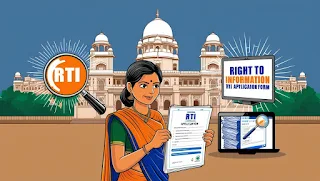RTI Act 2005: Empowering Citizens, Strengthening Democracy
Here's a comprehensive overview of the Right to Information (RTI) Act, 2005, along with relevant multiple-choice questions (MCQs) tailored for law-related examinations.
📘 Right to Information (RTI) Act, 2005 – Overview
The Right to Information Act, 2005 is a pivotal legislation enacted by the Parliament of India to promote transparency and accountability in the functioning of public authorities. It empowers citizens to access information under the control of public authorities, thereby fostering an informed citizenry and enhancing the democratic process.
🔑 Key Features:
-
Enactment Date: 15th June 2005
-
Commencement Date: 12th October 2005
-
Applicability: All of India, except the State of Jammu and Kashmir (now applicable post the abrogation of Article 370)
-
Objective: To empower citizens, promote transparency and accountability in the working of the Government, contain corruption, and make our democracy work for the people in real sense .(MCRHRDI, Scribd, NIC India)
🏛️ Structure:
-
Public Authorities: All authorities and bodies established or constituted by the Constitution, by any law made by the Parliament or State Legislature, or by notification issued or order made by the appropriate Government.
-
Public Information Officers (PIOs): Designated officers in each public authority responsible for providing information to applicants.
-
Appellate Authorities: Senior officers in public authorities to whom appeals can be made against the decisions of PIOs.
-
Central and State Information Commissions: Independent bodies established to oversee the implementation of the RTI Act and adjudicate on appeals and complaints.(Scribd)
📄 Rights Under the Act:
Under Section 2(j) of the RTI Act, the right to information includes:
-
Inspection of work, documents, and records.
-
Taking notes, extracts, or certified copies of documents or records.
-
Taking certified samples of material.
-
Obtaining information in the form of diskettes, floppies, tapes, video cassettes, or in any other electronic mode or through printouts where such information is stored in a computer or in any other device .(Testbook, Directorate General Resettlement)
⏱️ Timeframes:
-
General Requests: Information must be provided within 30 days of the request.
-
Life and Liberty Cases: Information must be provided within 48 hours.
-
Third-Party Information: If the request involves information pertaining to a third party, the PIO must give a notice to the third party within 5 days and make a decision within 40 days from the date of the request.(Testbook)
❌ Exemptions:
Section 8 of the RTI Act outlines specific exemptions where information may not be disclosed, including:
-
Information that would prejudicially affect the sovereignty and integrity of India.
-
Information expressly forbidden by any court of law or tribunal.
-
Information that would cause a breach of privilege of Parliament or the State Legislature.
-
Information including commercial confidence, trade secrets, or intellectual property, the disclosure of which would harm the competitive position of a third party.(Testbook)
Right to information opens up government’s records to public scrutiny, thereby strengthening the four important pillars of Good Governance- Transparency, Accountability, Predictability and Participation.
📝 Multiple Choice Questions (MCQs) on RTI Act, 2005
-
When did the RTI Act, 2005 come into force?
a) 15th June 2005
b) 12th October 2005
c) 1st January 2006
d) 26th January 2005
Answer: b) 12th October 2005 -
Who is responsible for providing information to applicants under the RTI Act?
a) Chief Information Commissioner
b) Appellate Authority
c) Public Information Officer (PIO)
d) Central Vigilance Commission
Answer: c) Public Information Officer (PIO) -
What is the time limit for providing information in cases concerning the life and liberty of a person?
a) 24 hours
b) 48 hours
c) 72 hours
d) 7 days
Answer: b) 48 hours -
Which section of the RTI Act deals with exemptions from disclosure of information?
a) Section 6
b) Section 7
c) Section 8
d) Section 9
Answer: c) Section 8 -
Under the RTI Act, who appoints the State Chief Information Commissioner?
a) President of India
b) Chief Minister of the State
c) Governor of the State
d) Prime Minister of India
Answer: c) Governor of the State -
Which of the following is NOT considered 'information' under the RTI Act?
a) Log books
b) Circulars
c) File notings
d) Data held in electronic form
Answer: c) File notings -
If a PIO fails to provide information within the stipulated time, it is termed as:
a) Contempt
b) Holding information
c) Timeout
d) Deemed refusal
Answer: d) Deemed refusal -
Which of the following organizations is NOT exempted under the Second Schedule of the RTI Act?
a) Intelligence Bureau
b) Research and Analysis Wing
c) National Security Guard
d) Government Railway Police
Answer: d) Government Railway Police -
What is the fee for filing an RTI application?
a) Rs. 5
b) Rs. 10
c) Rs. 15
d) Rs. 20
Answer: b) Rs. 10 -
Which section of the RTI Act allows partial disclosure by severing exempted information?
a) Section 8
b) Section 9
c) Section 10
d) Section 11
Answer: c) Section 10
For a comprehensive list of MCQs and further practice, you may refer to the following resources:
If you require a downloadable PDF version of the RTI Act or additional study materials, feel free to ask!





0 Comments
If you have any doubt, please visit my YouTube Channel "Law for RPF LDCE" and comments your request.